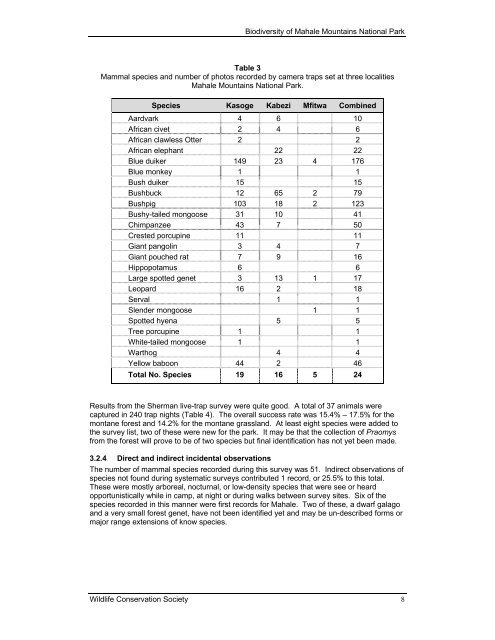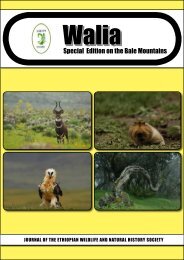Biodiversity of Mahale Mountains National Park, Tanzania | Report ...
Biodiversity of Mahale Mountains National Park, Tanzania | Report ...
Biodiversity of Mahale Mountains National Park, Tanzania | Report ...
Create successful ePaper yourself
Turn your PDF publications into a flip-book with our unique Google optimized e-Paper software.
<strong>Biodiversity</strong> <strong>of</strong> <strong>Mahale</strong> <strong>Mountains</strong> <strong>National</strong> <strong>Park</strong><br />
Table 3<br />
Mammal species and number <strong>of</strong> photos recorded by camera traps set at three localities<br />
<strong>Mahale</strong> <strong>Mountains</strong> <strong>National</strong> <strong>Park</strong>.<br />
Species Kasoge Kabezi Mfitwa Combined<br />
Aardvark 4 6 10<br />
African civet 2 4 6<br />
African clawless Otter 2 2<br />
African elephant 22 22<br />
Blue duiker 149 23 4 176<br />
Blue monkey 1 1<br />
Bush duiker 15 15<br />
Bushbuck 12 65 2 79<br />
Bushpig 103 18 2 123<br />
Bushy-tailed mongoose 31 10 41<br />
Chimpanzee 43 7 50<br />
Crested porcupine 11 11<br />
Giant pangolin 3 4 7<br />
Giant pouched rat 7 9 16<br />
Hippopotamus 6 6<br />
Large spotted genet 3 13 1 17<br />
Leopard 16 2 18<br />
Serval 1 1<br />
Slender mongoose 1 1<br />
Spotted hyena 5 5<br />
Tree porcupine 1 1<br />
White-tailed mongoose 1 1<br />
Warthog 4 4<br />
Yellow baboon 44 2 46<br />
Total No. Species 19 16 5 24<br />
Results from the Sherman live-trap survey were quite good. A total <strong>of</strong> 37 animals were<br />
captured in 240 trap nights (Table 4). The overall success rate was 15.4% – 17.5% for the<br />
montane forest and 14.2% for the montane grassland. At least eight species were added to<br />
the survey list, two <strong>of</strong> these were new for the park. It may be that the collection <strong>of</strong> Praomys<br />
from the forest will prove to be <strong>of</strong> two species but final identification has not yet been made.<br />
3.2.4 Direct and indirect incidental observations<br />
The number <strong>of</strong> mammal species recorded during this survey was 51. Indirect observations <strong>of</strong><br />
species not found during systematic surveys contributed 1 record, or 25.5% to this total.<br />
These were mostly arboreal, nocturnal, or low-density species that were see or heard<br />
opportunistically while in camp, at night or during walks between survey sites. Six <strong>of</strong> the<br />
species recorded in this manner were first records for <strong>Mahale</strong>. Two <strong>of</strong> these, a dwarf galago<br />
and a very small forest genet, have not been identified yet and may be un-described forms or<br />
major range extensions <strong>of</strong> know species.<br />
Wildlife Conservation Society 8
















